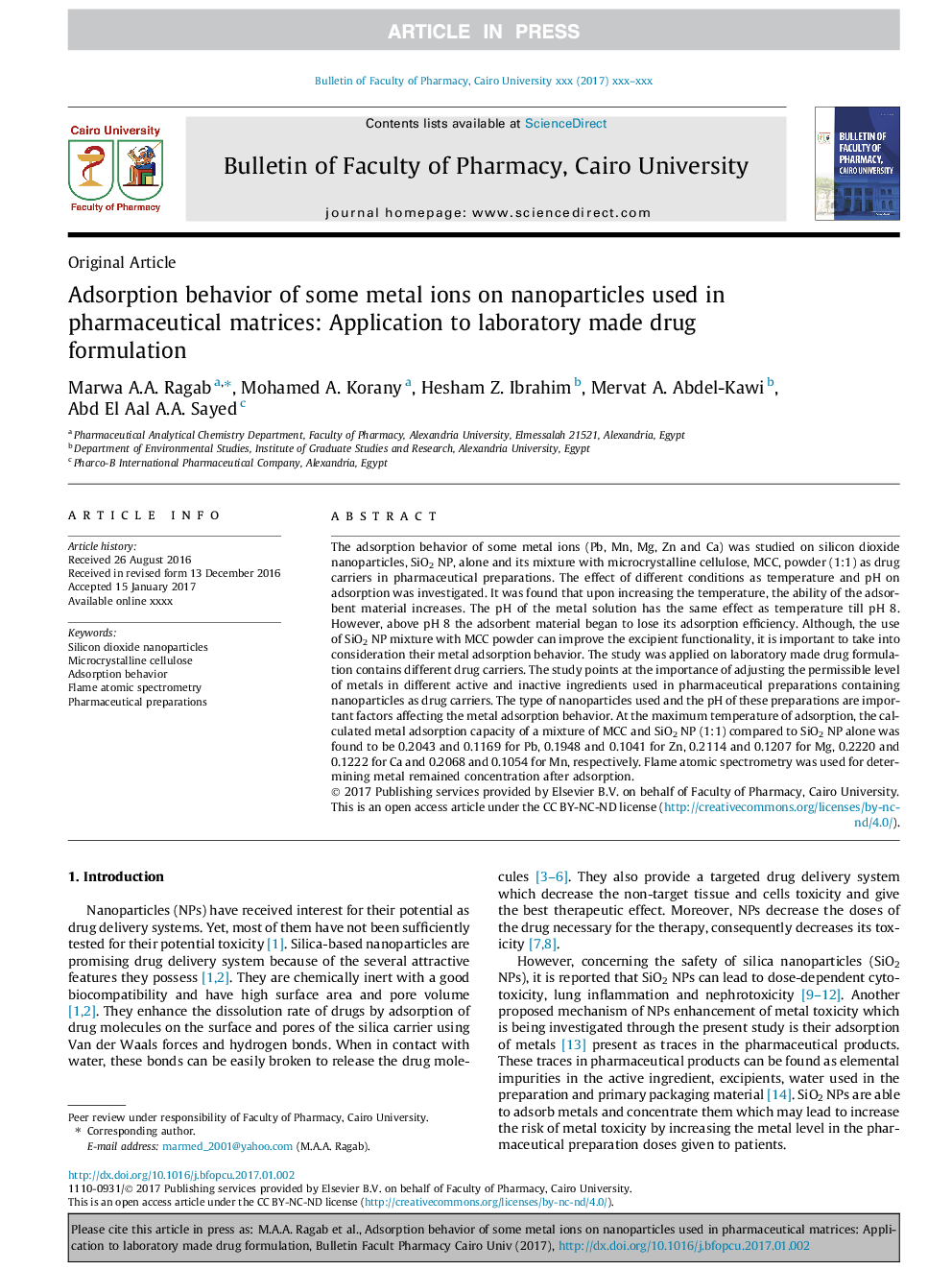| کد مقاله | کد نشریه | سال انتشار | مقاله انگلیسی | نسخه تمام متن |
|---|---|---|---|---|
| 8509198 | 1556009 | 2017 | 8 صفحه PDF | دانلود رایگان |
عنوان انگلیسی مقاله ISI
Adsorption behavior of some metal ions on nanoparticles used in pharmaceutical matrices: Application to laboratory made drug formulation
ترجمه فارسی عنوان
رفتار جذب برخی از یون های فلزی بر روی نانوذرات مورد استفاده در ماتریس های دارویی: کاربرد در فرمولاسیون دارویی آزمایشگاهی
دانلود مقاله + سفارش ترجمه
دانلود مقاله ISI انگلیسی
رایگان برای ایرانیان
کلمات کلیدی
نانوذرات دی اکسید سیلیکون، سلولز های میکروکریستالی، رفتار جذب، طیف سنج اتمی شعله، داروهای دارویی،
موضوعات مرتبط
علوم پزشکی و سلامت
داروسازی، سم شناسی و علوم دارویی
اکتشاف دارویی
چکیده انگلیسی
The adsorption behavior of some metal ions (Pb, Mn, Mg, Zn and Ca) was studied on silicon dioxide nanoparticles, SiO2 NP, alone and its mixture with microcrystalline cellulose, MCC, powder (1:1) as drug carriers in pharmaceutical preparations. The effect of different conditions as temperature and pH on adsorption was investigated. It was found that upon increasing the temperature, the ability of the adsorbent material increases. The pH of the metal solution has the same effect as temperature till pH 8. However, above pH 8 the adsorbent material began to lose its adsorption efficiency. Although, the use of SiO2 NP mixture with MCC powder can improve the excipient functionality, it is important to take into consideration their metal adsorption behavior. The study was applied on laboratory made drug formulation contains different drug carriers. The study points at the importance of adjusting the permissible level of metals in different active and inactive ingredients used in pharmaceutical preparations containing nanoparticles as drug carriers. The type of nanoparticles used and the pH of these preparations are important factors affecting the metal adsorption behavior. At the maximum temperature of adsorption, the calculated metal adsorption capacity of a mixture of MCC and SiO2 NP (1:1) compared to SiO2 NP alone was found to be 0.2043 and 0.1169 for Pb, 0.1948 and 0.1041 for Zn, 0.2114 and 0.1207 for Mg, 0.2220 and 0.1222 for Ca and 0.2068 and 0.1054 for Mn, respectively. Flame atomic spectrometry was used for determining metal remained concentration after adsorption.
ناشر
Database: Elsevier - ScienceDirect (ساینس دایرکت)
Journal: Bulletin of Faculty of Pharmacy, Cairo University - Volume 55, Issue 1, June 2017, Pages 155-162
Journal: Bulletin of Faculty of Pharmacy, Cairo University - Volume 55, Issue 1, June 2017, Pages 155-162
نویسندگان
Marwa A.A. Ragab, Mohamed A. Korany, Hesham Z. Ibrahim, Mervat A. Abdel-Kawi, Abd El Aal A.A. Sayed,
